Digital transformation Chisinau – 2030
Strategy covers the main initiatives for collaborative, connected and responsive city. The document also integrates digital technologies and uses city-wide data to respond to citizens’ needs.
Chisinau will offer its citizens in a sustainable way the highest quality of living and the best entrepreneurial climate, through intelligent and innovative solutions.
The digital transformation framework was developed to describe the objective and scope of the programme. It covers the main initiatives that need to be undertaken to deliver the expected results.
It also covers important projects where information and communication technologies (ICT) will play a significant role and bring added value, focusing on key societal areas.
DIGITAL TRANSFORMATION FRAMEWORK
Introduction
A digital transformation program has many dimensions and is a long-term program with long lasting effects . It is therefore of utmost importance to have a clear framework to explain, understand and scope the program. For the City leaders, this represents a good model to understand, agree upon and execute the digital transformation strategy or roadmap. It will enable Chisinau to transform as a City to meet its future challenges and deliver its future aspirations.
The framework as proposed is based upon the experience of other smart city programs and it is focused on the enabling processes, (actions, and/or supporting initiatives) by which the innovative use of technology and data, together with organizational change, can reach the final objective and help deliver the Vision for Chisinau City in more efficient, effective, and sustainable ways.
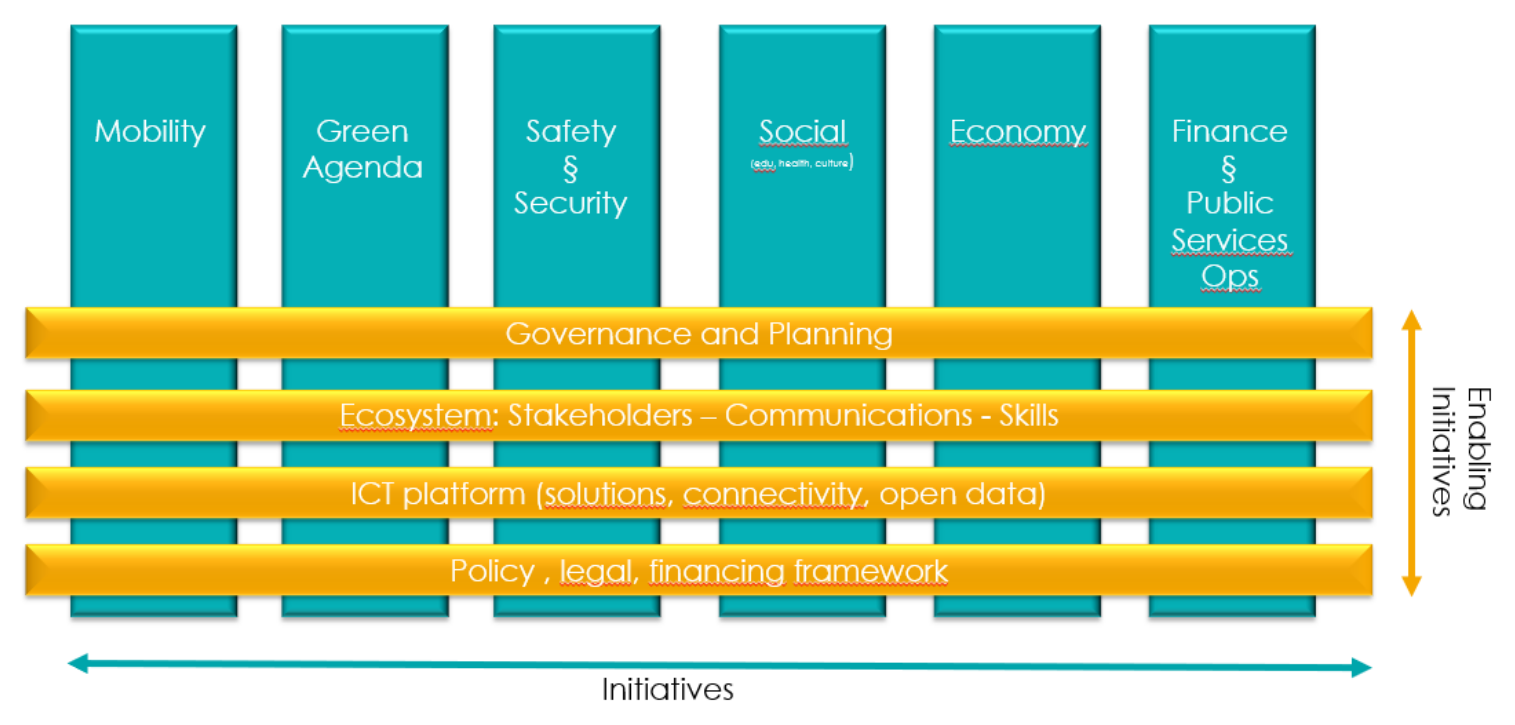 Initiatives
Initiatives
The pillars on the diagram reflect the initiatives. These are domains of activity, under the control of the city, which have a logical coherence. They are often also under a specific responsibility of a deputy mayor, or department within the city hall. Within each initiative several projects should be launched, with specific deliverables, timeline, budget, and outcomes.
We have identified, for the moment, 6 core “initiatives” or “domains” where the Chisinau smart city 2030 program must focus on to achieve the final objective.
-
Mobility
Mobility includes the overall agenda for citizens/businesses to move and operate smoothly, ecologically, and respectfully for the livelihood of the city. SMART Mobility is improving local, national, and international accessibility, through the provision of a wellorganized transport system and excellent availability of supporting IT services . It includes public transport, cars, traffic management, bicycle and pedestrian support, and parking management.
-
Green Agenda
The Green agenda covers all measurements, actions to help the city in being energy consumption effective, being ecologically correct, and take care for soil, water, and air to reduce pollution. It also covers waste management and the ambitions for a circular industry.
-
Safety & Security
Safety and security cover the “citizen” safety agenda, the overall well-being and sense of protection. It includes monitoring and in case of emergencies, the best organization of support services. As a special attention point, in a “digital world” it focuses also on cyber security threats and protection.
-
Social
The City has direct responsibility in offering services for the social agenda of the citizens. Most importantly are the educational system (schools, kindergarten), the health systems (hospitals and primary care), the cultural sector (museums, theater, etc.) and individual social programs.
-
Economy
As a core objective of the “Digital Transformation Chisinau 2030 program” prevails also the ambition for an “ entrepreneurial climate” within the business sector. As such the specific actions and projects should be bundled which focus on this. This mostly includes the avoidance of red tape and offering in a digital way online services and data as needed.
-
Finance & Public Services Operations
The city hall administration and processes should be optimized to support citizens and businesses. All activities, actions, projects which ambition to digitally transform the city hall are bundled within this initiative. This includes the financial management of the city, the ICT service delivery and the offering of online services.
If during the lifecycle of the Chisinau smart city 2030 program specific new , or re-grouping of activities could be beneficial, then these initiatives can be regrouped or added.
Enabling initiatives
Initiatives are key programs, projects which offer “value” to citizens and businesses.
However, these programs can only be executed when they are supported by “enabling initiatives”. The 4 enabling initiatives as identified are:
-
Governance and Planning
The complexity and multi-dimensional nature of digital transformation programs do require an explicit and clear governance structure. This governance will also need to plan, and iteratively adapt targets/content and timelines of the programs.
-
Ecosystem: stakeholder management, communications, skills
The ultimate success of digital transformation programs only materializes when the user, the citizen, the businesses participate, use and comment on the services offered. Furthermore, these programs should be explained, communicated and discussed with these stakeholders. Within the same context, the inherent ICT maturity of these users should be boosted with a targeted skills campaign. All these initiatives are bundled under the “ecosystem” definition.
-
ICT platform (solutions, connectivity, open data)
As stated in the vision, these outcomes are realized by innovative smart solutions. Experience has taught us that a coherent ICT strategy, based upon ubiquitous connectivity, internet, open data, and modern applications (mostly cloud based) are essential for the uptake of smart city programs.
-
Policy, legal, financing
Last but not least, new forms of legislation – including public private partnership, and new procurement models – will be needed to engage different stakeholders in the realization of the objectives. Also, local regulatory frameworks need coherent adjustments.
A special attention should be paid to develop national and local financial capacities, as well as to attract private and international resources to reach the objectives.
GOVERNANCE & PLANNING
The successful execution of the Digital Transformation Chisinau 2030 plan will require a consistent, focused, and explicit governance model and planning process.
The correlation of the successful execution of projects with the management of these projects is extremely high.
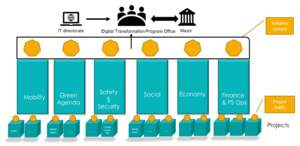
The first level of management deals with the “projects” themselves. These projects fit within an initiative (mobility, green, back-end etc.) and have a clear scope and target outcome. It is important to clearly appoint and empower the project leaders for these separate projects.
Projects support a “initiative”, and as such they are consolidated under this initiative to contribute to the overall ambition. For the larger scope of managing the Digital Transformation agenda all the initiatives are core for the final success. From that perspective, the governance model proposes to have an “initiative owner” who overlooks the different projects within this domain. The initiative owner can consolidate the results, pay attention to cross-over
benefits, indicate dependencies, put the right priorities and align the projects. As such an “initiative owner” is a real “role” within the city hall Chisinau Digital Transformation 2030 program. This role can be assimilated by a dedicated person, a deputy mayor or an external “empowered” expert.
Initiative owners form “together” the Digital Transformation 2030 program. They meet together in the Digital Transformation Program Office (DTPO). This office de facto reports into the mayor, to have a direct link with the executives. The ICT board, as a main expert contributor for the fulfillment of the Digital Transformation program, is a fixed member of the DTPO.
Dedicated “experts” could be added or invited occasionally to this program office.
The internal processes, roles & responsibilities of all stakeholders in the DTPO are defined in a clear RACI model, this means a clear indication as “Responsible, Accountable, Consulted or Informed” member.
It is recommended as part of a successful trajectory to include these aspects related to governance and capabilities (the people and skills needed) to carry out the program.
ECOSYSTEM
Stakeholders – Communications – Skills
Digital Transformation programs require a very broad engagement of different stakeholders. From a pure “service consumption” or beneficial point of view, the key target stakeholders are the citizens, from young to old, from engaged to socially supported, and the businesses. The core business of the City Hall is to offer best living conditions and services to these key stakeholders. This is also clearly reflected in the vision statement of Chisinau Digital Transformation 2030.
As part of the fulfillment of the ambition of this program attracting new stakeholders and activation of new external sponsorships should be contacted and consulted. The ambitions of the program are of this order that international government programs could be involved, as also private investors. Especially highly capital demanding projects in energy efficiency, consumption or smart building initiatives do require external sponsors and investors.
Most of the services, which will be offered in an innovative way, thanks to the usage of ICT technologies, will be based upon contributions of different governmental agencies on a national level (social, health, security, etc.), different agencies like police, emergency services, or the e-government agencies. Online services are most effective as they do allow to “integrate” this service delivery and optimize the bureaucratic process (red tape). From that perspective all these agencies are crucial stakeholders to make the Chisinau Digital Transformation 2030 program effective.
Digital literacy, digital awareness and knowledge are the cornerstone of the program. The scholar system can heavily rely upon the content creation, as provided by Tekwill or other similar players. Exploitation of the data, as residing in national or city registries can be exploited by developers in creative startups, or renown actors. All these “experts” are key stakeholders to engage in the execution of the program.
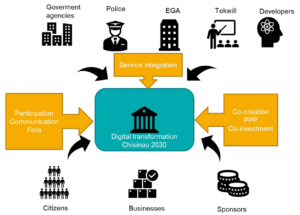
The “engagement” of all these actors “citizens, businesses, sponsors, agencies, technology providers” require a specific program attention: stakeholder management. This management starts with a clear transparent communication plan, dedicated
information sessions and information portals, multidisciplinary project engagements, and new contracting models like public private partnerships.
A careful analysis of other Digital Transformation programs clearly indicates the importance of this aspect of the program. It could be considered to have a sound communications program and key responsibility as part of the DTPO.
ICT PLATFORM
Solutions, connectivity, open data
The vision statement clearly indicates that the “smart” dimension comes from the innovative smart solutions, based upon the creative usage of ICT technologies.
It is therefore of utmost importance to pay correct attention to the “platform” which needs to be created to offer these smart solutions. A platform is the combined offering of networking, computing , and application development models which allow a consistent, open, and future proof services model.
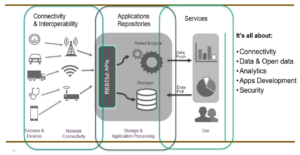
Key ingredients of the ICT platform could be summarized into solutions, connectivity and open data.
-
Solutions
The ultimate goal is to offer to end-users services, or applications which really benefit them in their usage. These solutions range from reservation services, ticketing services, information services, payment services, monitoring services etc. They are offered in a very flexible way, on mobile phones, laptops and PC’s or information kiosks or terminals. Information can be retrieved or entered in a user-friendly way. The architecture of these software applications has to adhere to new insights into software, and apply cloud native programming concepts, open API’s (application programming interfaces) and open-source licensing models.
-
Connectivity
Thanks to the internet, today’s world allows ubiquitous connectivity (everywhere, always). In general, this connectivity can be summarized as the availability of high-speed internet (fiber based, even the last mile), and high speed mobile networks ( 5G). The importance of this last technology refers also to the inherent introduction of IoT(internet of things) which is reflected by sensors and devices, everywhere in the city. These sensors and devices collect the data to be stored, analyzed, and managed and give insights and better services to the citizens. The preparation of “intelligent” or “smart” applications is based upon the availability of these networks and connectivity. The involvement and alignment
with telco providers or utility companies is crucial to develop the Digital Transformation program for the future. -
Open data
Apart from connectivity, the utilization of this data, or existing data registries is another cornerstone of a Digital Transformation program.
Within the realm of a city a lot of data is managed by the city hall. This data is sometimes private, but sometimes could also be used to optimize the delivery of some services (land information, contract information, ownership, etc.) The opening of these registries to be exploited and used in different applications is a real booster of the Digital Transformation program adoption. There are clear policy guidelines, and technical standards as proposed to make this happen. Furthermore, as already covered in the connectivity chapter, the gathering of data through the use of sensors and measuring devices (e.g. smart metering) will explode.
The collection of this data is important, and the development of smart applications to exploit the insights out of this.Most importantly in the creation of the ICT platforms is to adhere to some important criteria.
- Technical solutions are based on open standards;
- Data is made available internally and externally (open data);
- Technical solutions are built modularly;
- Systems are built on common digital platforms (internet, cloud).
POLICY, REGULATIONS, BUDGET
The creation of the Digital Transformation can not only be dealtwith by focusing on the technical matters. In fact, the legal framework and the business model and financing are crucial.
-
Policy and legal regulations
Legal regulations should be checked and adopted to deal with crucial elements like open data, data protection, cyber security, ownership, privacy. A correct assessment should be made of the actual legislation and policy framework, and corrective actions/decisions taken.
-
Financing models
Financing discussions and decisions are an integral part of a successful implementation and must be factored into evaluations. The investment into the Digital Transformation platform is significant, although not profound when put in context of the overall operation budget of a city. However, it is worthwhile to consider different formats of financing.
Financing could come from different scenarios:- Internal financing from capital budget
- Internal financing from operating budgets (but often shared between departments)
- Public grants (national or international sponsors)
- Industry Research & Development (typically as part of pilots)
- Industry PPP (potentially bundling a number of services)
- Market funds (loans as part of projects, equity as part of concessions).
The recipient of value is often not the expender of cost. In principle the service providers rape the benefits and the technical support functions make the investments.
MASTERPLAN (DETAILED PLAN)
As explained in the methodology, after vision, objectives, and initiatives, it is important to line up the priorities, define a roadmap and timeline, and assure the resources and capabilities needed to launch and manage the program.
As it stands today, this document only wants to focus on the VISION of Chisinau Digital Transformation 2030, and offering a framework to show the right initiatives, programs as to understand the overall scope and ambition of the project.
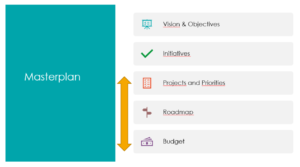
The next steps of the program include the following elements:
-
Priorities
Quite a number of initiatives contain a set of projects which have been partly started, partly envisaged or requested. It is important to select the right projects, prioritize them and select them. As the overall approach is also to build upon existing achievements and steps taken, it is important to do a right “as is” analysis of the situation to define the priorities and to use the existing platforms and systems at national level.
-
Roadmap
Putting a project on a timescale, and defining start and end-date, assumes the outline of a roadmap. Within the large scope of digital transformation programs, it is important to map quick wins, short term, mid-term and long-term projects. Long term projects will be needed to build the sustainable “platform” on which all further projects will be implemented.
-
Resources/capabilities
A careful analysis of the capabilities needed to fulfill the programs is needed. Capabilities assessment should be done regarding the “as is” situation but will definitely lead to the search for and definition of additional resources, expertise, involvement of stakeholders. Resources include human capital, and financing. This chapter also will suggest potential sources of capabilities to be contacted.
KPIs or METRICS
Measuring the outcomes of the Chisinau Digital Transformation 2030 program is a clear necessity. Monitoring the continuous progress and checking the outcomes of the investments and initiatives are best practices in overall program management.
However, the complexity of this program does require a “leveledkey performance indicator” model.
The model which is proposed is based upon the business value framework.
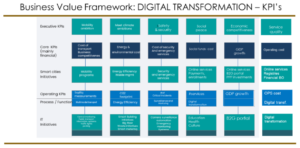
It clearly states a hierarchy of ambitions to achieve.
- At the upper level, the City Hall wants to achieve results which are directly linked to the value citizens/businesses experience from the service delivered by the city to them. They are not concerned about how a technical implementation has been done, but just about how well the mobility in general works in the city, or how clean the air is. These upper levels are the executive KPIs which should be consistent with the political agenda of the city Council.
Executive KPIs can be made “tangible” by trying to express them in some financial KPIs. Financial KPIs on City Hall level give quantitative evidence, and not only qualitative evidence. Some clear examples are “overall cost of public transport”, GDP growth of the city, operating costs of the city hall”. - The measurement of the initiatives can be done on 2 levels. One level are clear operating KPIs of these services, and the other level are clear measurements of the outcome of the specific projects.
The importance of the introduction of the business value framework translates into a right measurement model of success, which clearly shows that a Digital Transformation program is carried by ALL service activities of the City Hall and impacts all citizens. A partial measurement of initiatives or projects would not contribute to the right ambitions of this program.
This model is strongly aligned with the OKR methodology (objectives, key results) which also should guide the performance of the teams working on these programs.
CONCLUSIONS
This document outlines the key VISION statement for Chisinau Digital Transformation 2030. It has been elaborated based on a Digital Transformation framework, which allows to structure the different initiatives, the different enabling initiatives, and the individual projects into a holistic construct.
Moreover, the Vision is a reflection, in which we broaden the definition of a Digital Transformation beyond technology and will support the central role that Chisinau city plays in local and international development and enhance the exchange of best practices.
By focusing on how to build and deliver innovative initiatives with real impact (adjusted to the reality of Chisinau and uniqueness), we expect to help the Chisinau City Hall and other development partners to identify and ideate new ways of solving urban challenges – toward 2030, and beyond.
To steer and maintain the momentum of this program, a clear suggestion was made to create an Innovation Hub, or Digital Transformation Program Office.
Experience with other Digital Transformation programs, and the available literature has taught us some lessons to be taken or guidelines to be followed to make sure this program delivers upon its expectations.
Hierarchy of needs
According to Abraham Maslow’s theory around the pyramid hierarchy of needs, a model has been developed to show the hierarchy of program elements to be taken into consideration to make this program successful.
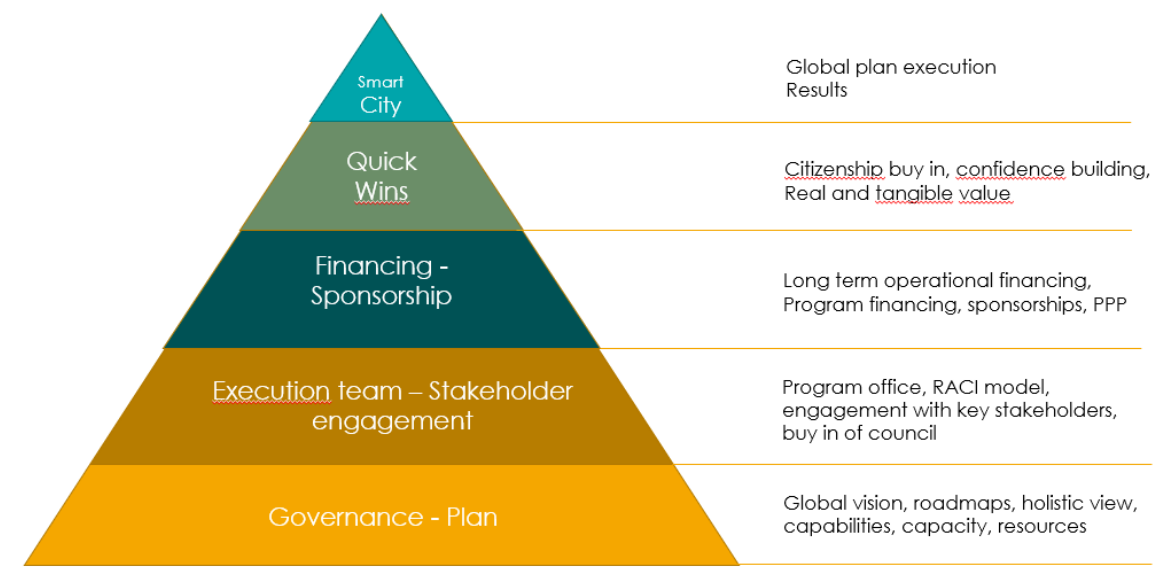
-
Level 1: Governance and plan
As clearly indicated a Digital Transformation plan is a multistakeholder, multi- annual, multi- faceted program. The core condition for success is the proper governance model, the clear vision and objective setting, and a right analysis of capabilities and resources to make it happen. Strategy without execution is hallucination.
-
Level 2: Execution team – Stakeholder engagement
The availability of experts, project leaders, ICT professionals is mandatory to make it happen. Technology will not only make the difference. A conditio sine qua non is the creation of this Digital Transformation program office, with initiative leaders with a clear objective and masterplan. As explained in the ecosystem chapter, the connection and involvement of the different stakeholders is another condition for success. Services, service integration and digital transformation does require the close connection with the users, application, and process owners.
-
Level 3: Financing – sponsorship
Digital Transformation projects have a vast ambition and landscape of investments. Some of the infrastructural activities, or energy efficiency investments will require proper financing schemes. As explained in the financing enabling initiative this will require proactive creative thinking and new financing and co-operation models.
-
Level 4: Quick wins
Although Chisinau Digital Transformation 2030 ambitions tangible results for 2030, this does not stop it from achieving breakthrough offerings or quick wins in shorter time frames. Some important steps have been taken to deal with things like mobility, online service, or payment programs. Also, the creation of core data registries allows rapid value add service offerings to be defined and executed.
The focus on some quick wins, in parallel with the sustainable platform and visionary objectives, will assure stakeholder motivation and confidence in the final outcomes. This should be an inherent part of the strategy. -
Level 5: Digital Transformation program
The ultimate goal is to achieve the outcome of the overall plan. It will be a journey of several years. The common understanding and acceptance of the vision, and a full commitment to the required enabling initiatives will lead to the final results, and to the achievement of the 2 target objectives: a high quality of living for its citizens and visitors, and a prosperous entrepreneurial climate for its businesses.

